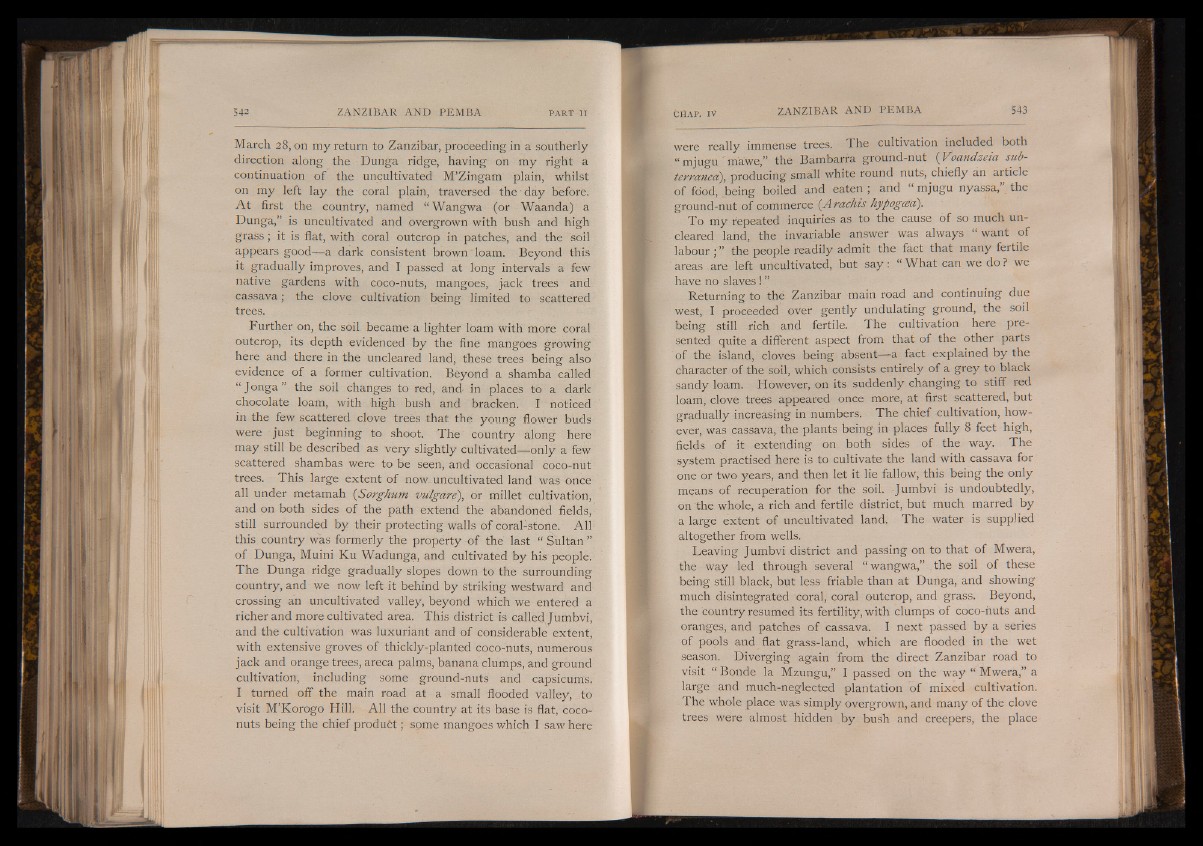
March 28, on my return to Zanzibar, proceeding in a southerly
direction along the Dunga ridge, having on my right a
continuation of the uncultivated M'Zingam plain, whilst
on my left lay the coral plain, traversed the day before.
A t first the country, named “ Wangwa (or Waanda) a
Dunga,” is uncultivated and overgrown with bush and high
grass; it is flat, with coral outcrop in patches, and the soil
appears good— a dark consistent brown loam. Beyond this
it gradually improves, and I passed at long intervals a few
native gardens with coco-nuts, mangoes, jack trees and
cassava; the clove cultivation being limited to scattered
trees.
Further on, the soil became a lighter loam with more coral
outcrop, its depth evidenced by the fine mangoes growing
here and there in the uncleared land, these trees being also
evidence of a former cultivation. Beyond a shamba called
“ Jonga” the soil changes to red, and- in places to a dark
chocolate loam, with high bush and bracken. I noticed
in the few scattered clove trees that the young flower buds
were just beginning to shoot. The country along here
may still be described as very slightly cultivated— only a few
scattered shambas were to be seen, and occasional coco-nut
trees. This large extent of now uncultivated land was once
all under metamah (Sorghum vulgare), or millet cultivation,
and on both sides of the path extend the abandoned fields,
still surrounded by their protecting walls of coraFstone. All
this country was formerly the property of the last “ Sultan ”
of Dunga, Muini Ku Wadunga, and cultivated by his people.
The Dunga ridge gradually slopes down to the surrounding
country, and we now left it behind by striking westward and
crossing an uncultivated valley, beyond which we entered a
richer and more cultivated area. This district is called Jumbvi,
and the cultivation was luxuriant and of considerable extent,
with extensive groves of thickly-planted coco-nuts, numerous
jack and orange trees, areca palms, banana clumps, and ground
cultivation, including some ground-nuts and capsicums.
I turned off the main road at a small flooded valley, to
visit M’Korogo Hill. All the country at its base is flat, coconuts
being the chief product; some mangoes which I saw here
were really immense trees. The cultivation included both
“ mjugu mawe,” the Bambarra ground-nut ( Voandzeia sub-
terranea), producing small white round nuts, chiefly an article
of food, being boiled and eaten ; and “ mjugu nyassa,” the
ground-nut of commerce (Arachis hypogcza).
To my repeated inquiries as to the cause of so much uncleared
land, the invariable answer was always “ want of
labour ; ” the people readily admit the fact that many fertile
areas are left uncultivated, but say: “ What can we do? we
have no slaves ! ”
Returning to the Zanzibar main road and continuing due
west, I proceeded over gently undulating ground, the soil
being still rich and fertile. The cultivation here presented
quite a different aspect from that of the other parts
of the island, cloves being absent— a fact explained by the
character of the soil, which consists entirely of a grey to black
sandy loam. However, on its suddenly changing to stiff red
loam, clove trees appeared once more, at first scattered, but
gradually increasing in numbers. The chief cultivation, however,
was cassava, the plants being in places fully 8 feet high,
fields of it extending on both sides of the way. The
system practised here is to cultivate the land with cassava for
one or two years, and then let it lie fallow, this being the only
means of recuperation for the soil. -Jumbvi is undoubtedly,
on the whole, a rich and fertile district, but much marred by
a.large extent of uncultivated land. The water is supplied
altogether from wells.
Leaving Jumbvi district and passing on to that of Mwera,
the way led through several “ wangwa,” the soil of these
being still black, but less friable than at Dunga, and showing
much disintegrated coral, coral outcrop, and grass. Beyond,
the country resumed its fertility, with clumps of coco-nuts and
oranges, and patches of cassava. I next passed by a series
of pools and flat grass-land, which are flooded in the wet
season. Diverging again from the direct Zanzibar road to
visit “ Bonde la Mzungu,” I passed on the way “ Mwera,” a
large and much-neglected plantation of mixed cultivation.
The whole place was simply overgrown, and many of the clove
trees were almost hidden by bush and creepers, the place